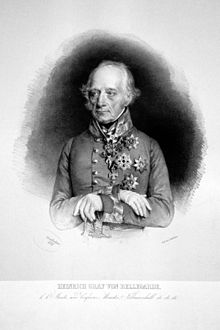- Count Heinrich von Bellegarde
-
Count Heinrich von Bellegarde, Viceroy of Lombardy-Venetia (German: Heinrich Joseph Johannes, Graf von Bellegarde, or sometimes Heinrich von Bellegarde), (29 August 1756 – 22 July 1845) was born in Saxony, later joined the Austrian army, became a general officer, and fought in the French Revolutionary Wars and the Napoleonic Wars. He became a Generalfeldmarschall and statesman.
Contents
Early career
Born in Dresden in the Electorate of Saxony on 29 August 1756, Bellegarde first served in the Saxon army. Transferring his services to Austria in 1771, Bellegarde became an Oberst (colonel) in 1785 and distinguished himself greatly leading dragoons in the Austro-Turkish War (1787-1791). After being appointed a General-Major in 1792, he fought in the War of the First Coalition in the Netherlands campaigns of 1793-1794. After winning promotion to Feldmarshal-Leutnant, he served on the staff of the Archduke Charles in the fighting in Germany. He accompanied Charles to Italy in the following year. He was also employed in the congress of Rastatt.
In 1799 Bellegarde commanded a corps in eastern Switzerland, connecting the armies of Archduke Charles and Aleksandr Suvorov, and finally joined the latter in north Italy. He conducted the siege of the citadel of Alessandria, and was present at the decisive Battle of Novi. After the Austrian defeat at the Battle of Marengo (in which his brother Friedrich Bellegarde commanded a brigade), Emperor Francis II of Austria appointed Bellegarde to command the army in Italy with the rank of General of Cavalry. On 25 December, the French defeated Bellegarde at the Battle of Pozzolo.
Napoleonic Wars
In 1805, when Archduke Charles left to take command in Italy, Bellegarde became president ad interim of the council of war. He was, however, soon employed in the field, and at the sanguinary Battle of Caldiero he commanded the Austrian right.
In the War of the Fifth Coalition he commanded the I Armee Korps. He supervised the II Armee Korps, which was also posted on the north bank of the Danube River. Cut off from Archduke Charles as the result of the Battle of Eckmühl, he retreated into Bohemia, but managed to rejoin the main army before the great battles near Vienna. He led the I Korps in the battles of Aspern-Essling and Wagram. After the 1809 war, Bellegarde became a Feldmarschall. From 1809 to 1813 he was governor-general of Galicia, but was often called to preside over the meetings of the Aulic Council, especially in 1810 in connection with the reorganization of the Austrian army.
In 1813, 1814 and 1815 he led the Austrian armies in Italy. His successes in these campaigns were diplomatic as well as military, and he ended them by crushing the last attempt of Joachim Murat to regain the Kingdom of Naples in 1815. Between 1815 and 1816 he was Viceroy of Lombardy-Venetia. From 1816 to 1825 (when he had to retire owing to failing eyesight) he held various distinguished civil and military posts. He died in Vienna on 22 July 1845.
Notes
Regarding personal names: Graf is a title, translated as Count, not a first or middle name. The female form is Gräfin.
References
- Smith, Digby. The Napoleonic Wars Data Book. London: Greenhill, 1998. ISBN 1-85367-276-9
- Smola, Das Leben des Feldmarschalls Heinrich Graf von Bellegarde (Vienna, 1847).
 This article incorporates text from a publication now in the public domain: Chisholm, Hugh, ed (1911). Encyclopædia Britannica (11th ed.). Cambridge University Press.
This article incorporates text from a publication now in the public domain: Chisholm, Hugh, ed (1911). Encyclopædia Britannica (11th ed.). Cambridge University Press.
Categories:- Austrian nobility
- Austrian Field Marshals
- Austrian generals
- Austrian soldiers
- 1756 births
- 1845 deaths
- Knights Grand Cross of the Order of Saint Ferdinand and of Merit
- Austrian Empire military leaders of the French Revolutionary Wars
- Military leaders of the French Revolutionary Wars
- Austrian Empire commanders of the Napoleonic Wars
- Austrian military personnel by war
- Knights of the Order of Saint Hubert
Wikimedia Foundation. 2010.

